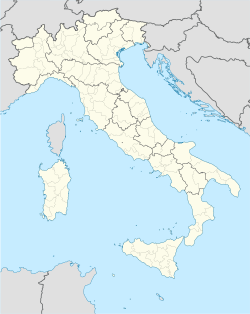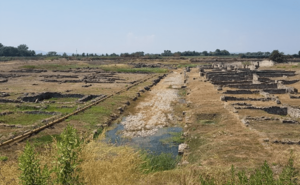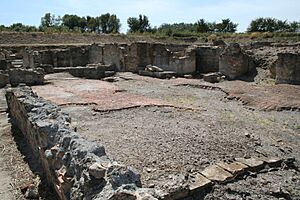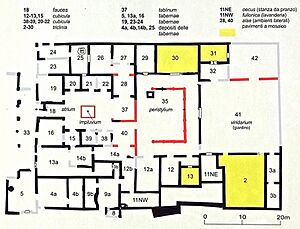Thurii facts for kids
|
Θούρῐοι (Thoúrioi)
|
|

Overview of excavated ruins, possibly from Thurii
|
|
| Alternative name | Θούρῐον (Thoúrion), Thurium, Copia, Copiae |
|---|---|
| Location | Sibari, Province of Cosenza, Calabria, Italy |
| Region | Bruttium |
| Coordinates | 39°43′2″N 16°29′44″E / 39.71722°N 16.49556°E |
| Type | Settlement |
| Site notes | |
| Website | ArcheoCalabriaVirtual |
Thurii was an ancient Greek city located in what is now Italy. It was built near or on the site of the famous city of Sybaris. You can find the ruins of Thurii in the Sybaris archaeological park, close to Sibari in the Province of Cosenza, Calabria.
Contents
History of Thurii
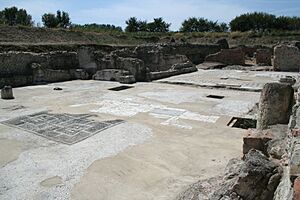
Founding the City
Thurii was founded in 443 BC. It was a new settlement started by Athens and some people who used to live in Sybaris.
Before Thurii, the old city of Sybaris was destroyed. After 58 years, some people from Sybaris tried to rebuild it. They were helped by leaders from Thessaly. The new settlement grew quickly. This made the people of Crotona jealous, and they forced the new settlers out after only five years.
The Sybarites asked Sparta for help, but they said no. Then, they asked the Athenians, who agreed to help. Pericles, a famous Athenian leader, sent a group of colonists. He wanted Thurii to be a "Panhellenic" colony. This meant it would welcome people from all over Greece, not just Athens.
Many famous people joined this new colony:
- Herodotus, a well-known historian.
- Lysias, a great speaker.
- Hippodamus, who designed the city.
The laws for Thurii were created by a wise man named Protagoras. He based them on the laws of Zaleucus from Locri.
The first settlers tried to build on the old Sybaris site. But they soon moved to a nearby spot. This new place had a spring called "Thuria," which gave the city its name.
Early on, there were disagreements between the original Sybarite settlers and the new colonists. The Sybarites wanted special rights. These arguments led to the Sybarites being forced out of Thurii. They tried to settle elsewhere but were eventually scattered by local tribes.
Thurii then made peace with Crotona. The city grew fast. Many new people came, especially from the Peloponnese. Even though it was an Athenian colony, Athenians were a small part of the population. The citizens were divided into ten groups, or tribes. Their names showed where they came from, like Arcadian, Achaean, and Athenian.
The government was a democracy, where citizens had a say. The city was well-planned with wide streets that crossed each other.
Wars and Challenges
Soon after it was founded, Thurii went to war with Tarentum (modern Taranto). They fought over a rich area called Siritis. The war ended with both sides agreeing to create a new colony, Heracleia, in the disputed land.
Later, Thurii faced more problems. During the big Sicilian Expedition by Athens, the city was divided. Some people wanted to help Athens, others did not. At first, Thurii stayed neutral. This was when Alcibiades, an Athenian general, escaped his captors in Thurii.
But two years later (413 BC), the group supporting Athens gained power. When Athenian generals Demosthenes and Eurymedon visited Thurii, the citizens helped them. They even sent soldiers to support Athens.
For over 20 years, Thurii was very prosperous. But around 390 BC, a new enemy, the Lucanians, started attacking. All the Greek cities in the area formed a group to protect themselves. However, the Thurians attacked the Lucanians on their own. They were badly defeated near Laüs, losing many soldiers.
This defeat greatly hurt Thurii. The growing power of the Lucanians and Bruttians nearby made it hard for the city to recover. Thurii also had problems with Dionysius of Syracuse.
Later, Thurii was so pressured by the Lucanians that it asked Rome for help. A Roman army, led by Gaius Fabricius Luscinus, came in 282 BC. They defeated the Lucanians and Bruttians, saving Thurii. But soon after, the Tarentines attacked and looted Thurii. This attack helped start a war between Rome and Tarentum.
Under Roman Rule
Thurii became a friend and ally of Rome. A Roman army was stationed there to protect it.
Thurii played a part in the Second Punic War against Hannibal. After a big battle, Thurii joined the side of Carthage. They even handed over Roman soldiers to the Carthaginian general Hanno.
Later, Hannibal moved some people from another city to Thurii. But he soon had to leave Thurii too. In 204 BC, when Hannibal left the area, he took 3500 important citizens from Thurii to Crotona. He then allowed his soldiers to plunder Thurii.
Thurii was in a very bad state. But because its land was so fertile, Rome wanted to keep it from being completely abandoned. So, in 194 BC, Rome sent a new group of settlers to create a Roman colony there. The Romans called this new colony Copiae. However, the old name Thurii was still used more often.
Thurii was still an important town during the Roman Republic. In 72 BC, it was attacked by Spartacus, a famous gladiator who led a slave rebellion. He made the city pay a lot of money but did not destroy it.
The family of the future Roman emperor Caesar Augustus was well-known in Thurii. His father, Gaius Octavius, defeated an army of Spartacus nearby. Because of this, the future emperor was given the nickname Thurinus after he was born.
During the Roman Civil Wars, Julius Caesar placed soldiers in Thurii to protect it. Later, in 40 BC, Sextus Pompeius attacked Thurii and its lands. But he was driven away from the city walls.
Thurii remained an existing town for a long time. It was still mentioned in the 6th century AD.
Why Thurii Was Abandoned
Over many years, the Crathis river carried a lot of mud and sand. This caused the river's mouth to move further into the sea, about one meter each year. As a result, the cities of Sybaris, Thurii, and Copia became landlocked. They lost their easy access to the sea for trade. This made them less important.
It seems Thurii was abandoned during the Middle Ages. The people moved to a new place called Terranova (Terranova da Sibari). This new town was about 15 km inland, on a hill.
The exact spot of ancient Greek Thurii is not fully known. But the Roman town, which was likely in the same area, is thought to be about 6 km east of Terranova da Sibari.
The Site Today
One special building found at the site is a large house called a domus. It is located behind the ancient theater. This house was very grand and belonged to a wealthy family. It was built around the 1st century BC and was used until the 5th century AD. It was expanded and changed over time. The house was most impressive between the 1st and 3rd centuries AD.
Ancient Coins
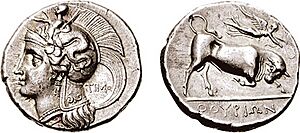 |
|
| Front: Athena's head with a helmet. | Back: A bull charging right. Above it, Nike (goddess of victory) flying. |
| Silver coin (Stater) from Thourioi, around 350-300 BC | |
Thurii had its own mint and made many beautiful coins. These coins show how rich and successful the city was.
Famous People from Thurii
- Alexis (an ancient writer of comedies)
- Herodotus, who moved to Thurii from Athens after 443 BC.
- Lysias, who moved to Thurii from Athens around 430 BC.
See also


